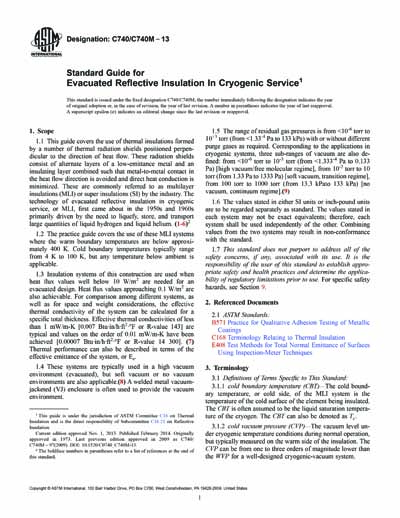Historical
ASTM C740/C740M-13
Standard Guide for Evacuated Reflective Insulation In Cryogenic Service
1.1 This guide covers the use of thermal insulations formed by a number of thermal radiation shields positioned perpendicular to the direction of heat flow. These radiation shields consist of alternate layers of a low-emittance metal and an insulating layer combined such that metal-to-metal contact in the heat flow direction is avoided and direct heat conduction is minimized. These are commonly referred to as multilayer insulations (MLI) or super insulations (SI) by the industry. The technology of evacuated reflective insulation in cryogenic service, or MLI, first came about in the 1950s and 1960s primarily driven by the need to liquefy, store, and transport large quantities of liquid hydrogen and liquid helium. (1-6)2
1.2 The practice guide covers the use of these MLI systems where the warm boundary temperatures are below approximately 400 K. Cold boundary temperatures typically range from 4 K to 100 K, but any temperature below ambient is applicable.
1.3 Insulation systems of this construction are used when heat flux values well below 10 W/m2 are needed for an evacuated design. Heat flux values approaching 0.1 W/m2 are also achievable. For comparison among different systems, as well as for space and weight considerations, the effective thermal conductivity of the system can be calculated for a specific total thickness. Effective thermal conductivities of less than 1 mW/m-K [0.007 Btu·in/h·ft2·°F or R-value 143] are typical and values on the order of 0.01 mW/m-K have been achieved [0.00007 Btu·in/h·ft2·°F or R-value 14 300]. (7) Thermal performance can also be described in terms of the effective emittance of the system, or Εe.
1.4 These systems are typically used in a high vacuum environment (evacuated), but soft vacuum or no vacuum environments are also applicable.(8) A welded metal vacuum-jacketed (VJ) enclosure is often used to provide the vacuum environment.
1.5 The range of residual gas pressures is from <10-6 torr to 10+3 torr (from <1.33-4 Pa to 133 kPa) with or without different purge gases as required. Corresponding to the applications in cryogenic systems, three sub-ranges of vacuum are also defined: from <10-6 torr to 10-3 torr (from <1.333-4 Pa to 0.133 Pa) [high vacuum/free molecular regime], from 10-2 torr to 10 torr (from 1.33 Pa to 1333 Pa) [soft vacuum, transition regime], from 100 torr to 1000 torr (from 13.3 kPato 133 kPa) [no vacuum, continuum regime].(9)
Content Provider
ASTM International [astm]






